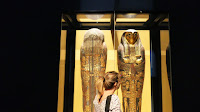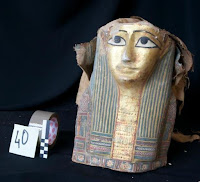Min. of Antiquities seeks to put Egyptian Museum in UNESCO World Heritage
Minister of Antiquities Khaled al-Anany visited the Egyptian Museum in Tahrir on Wednesday-Ministry of Antiquities' official Facebook page
The Ministry of Antiquities is working on a long-term plan to register the Egyptian Museum in Tahrir in the UNESCO World Heritage list, Minister of Antiquities Khaled al-Anany announced on Wednesday.
This was during Anany’s tour at the Egyptian Museum in Tahrir to follow up the upgrade of the displays in the exhibition space and the procedures the museum is set to take after Tutankhamun’s treasures are moved to the Grand Egyptian Museum.
Sailing Toward Osiris Review – Workers Along The Nile
Sailing Toward Osiris is an ancient Egyptian themed worker placement board game, which was released earlier this year (2018), by Daily Magic Games. Designed by W. David MacKenzie, with art from Denis Martynets, the game sees 2 – 5 players spend around 60 – 90 minutes (based on the player count) gathering resources, building grand monuments and negotiating. However, is Sailing Toward Osiris a title that is fit for the new Pharaoh? Let’s find out.
Ancient Egyptian graffiti, burial sites discovered by Yale archaeologists
A team of archaeologists — led by Yale Egyptologist John Darnell — has uncovered a “lost oasis” of archaeological activity in the eastern Egyptian desert of Elkab.
The researchers from the Elkab Desert Survey Project — a joint mission of Yale and the Royal Museums of Art and History Brussels working in collaboration with the Ministry of Antiquities and the Inspectorate of Edfu — surveyed the area of Bir Umm Tineidba, once thought to be devoid of any major archaeological remains. Instead, the team unearthed “a wealth of archaeological and epigraphic material,” says Darnell, including a number of examples of ancient rock art or “graffiti,” the burial site of an Egyptian woman, and a previously unrecorded, enigmatic Late Roman settlement.
The life of Queen Ankhesenamun, sister and wife of Tutankhamun
Ancient Egypt has captivated our imaginations for centuries. Egyptologists have made many fascinating discoveries over the years, but it seems as though just as many mysteries surrounding this ancient culture remain unsolved.
One of these mysteries is the story of Ankhesenamun; although inscriptions have been found that depict some parts of her life, the details are scant. This is in part due to the efforts of Horemheb, the last pharaoh of the 18th Dynasty, to destroy all trace of her father — who he branded a heretic king — and his lineage.
Storied Media Group To Produce Docuseries On Excavation At Egypt’s Valley Of The Kings
Ahead of the 100-year anniversary of the discovery of King Tut’s tomb, Storied Media Group has acquired the production and sponsorship rights to a large archeological excavation in Egypt’s Valley of the Kings, to begin in September, led by renowned Egyptologist and archaeologist Dr. Zahi Hawass. The project is being pitched to multiple networks as a docuseries and possible live-event special. Storied Media Group was selected by Egypt’s Ministry of Antiquities to document the event.
Ancient pottery found near River Nile dates to more than 4,000 years ago
Archaeologists in Egypt have discovered an ancient pottery manufacturing workshop dating to more than 4,000 years ago.
Thursday’s statement by the Antiquities Ministry says the workshop is situated close to the River Nile in Aswan province in southern Egypt.
The Color that Means Both Life and Death
Ancient Egyptians reserved green for the bold beryl complexion of their god of life and death, Osiris – ruler of the underworld, who held dominion over the passage of souls between this world and the next. Typical depictions of Osiris, such as one found on the 13th-Century BC walls of the burial tomb of Horemheb, the last monarch of the 18th dynasty of Egypt, portray a skinny, grassy-skinned god, whose false pharaoh’s beard marks him out as a deity of incontestable pre-eminence.
Important facts about Alexandria’s ancient sarcophagus
The ex-dean of the faculty of Archelogy Cairo University Mohamed Hamza revealed to Egypt Today some important facts about the 2,000-year-old sarcophagus that was unearthed in Alexandria.
Alexandria sarcophagus arrives at new display at Mustafa Kamel Necropolis
Egyptian Ship Model Sheds Light on Bronze Age Warfare and Religion
Building a virtual 3D model of the Gurob model revealed many secrets.
Ancient Egypt conjures visions of towering monuments and glittering gold, but it’s often the small, unassuming archaeological finds that yield the deepest insights. The exhibition Beyond the Nile: Egypt and the Classical World explores some of these underappreciated objects and what they can tell us about the complex interactions among ancient Egypt, Greece, and Rome. This small wooden ship-cart model from an Egyptian tomb is one example.
A 2,000-Year-Old Papyrus to Talk About the Medical Condition Called “Hysterical Apnea”
Finally, they found out what’s written on an ancient papyrus – there are details about a condition which is called “hysterical apnea,” which talks about how women who don’t have enough sex become hysterical. We all know that female hysteria was a common diagnosis once, and there are texts that show that the condition made its appearance back in 1900 BC in ancient Egypt. Hippocrates, who was the founder of medicine, also believed in the existence of this condition from the 5th century BC.
To the King, My Sun, My God, the Breath of My Life… Amarna Letters Paint Remarkable Picture of Ancient Egyptian Rulership
“Your city weeps, and her tears are running, and there is no help for us. For 20 years we have been sending to our lord, the king, the king of Egypt, but there has not come to us a word from our lord, not one.” Amarna Tablet
The Amarna Letters offer a remarkable insight into the hopes, fears, challenges and diplomatic life in ancient Egypt - requests for gold, offers of marriage, warning of a traitor, and promises of loyalty to the pharaoh – these are just some of the themes that appear in this remarkable collection. Numbering almost 400 clay tablets, the content inscribed provides scholars with an unrivalled peek into diplomatic life in Egypt and across the Middle East during the 14th century BC.
Famine Stela: A piece of Pharaonic diary
Famine Stela at Sehel Island in the Nile, Aswan, Upper Egypt- Egypt Today/Mahmoud Sheleib
In the era of King Djoser, King of Upper and Lower Egypt: Neterkhet and founder of the Third Dynasty in the Old Kingdom, a shortage of the Nile flood in 2,700 BC led to a seven-year famine, leaving Egypt in a state of extreme distress. The king was perplexed as grains were insufficient, seeds dried up, people robbed each other, and temples and shrines closed. Looking for an end to his people’s suffering, the king consulted his architect and prime minister, Imhotep, commanding him to dig for a solution in the old sacred texts. Obeying the king’s order, Imhotep headed to a temple in the ancient city of Ain Shams (Old Heliopolis), where he discovered that the solution could be found in the city of Yebu (Aswan or Elephantine), the source of the Nile.








































